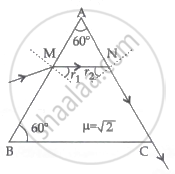Advertisements
Advertisements
Question
A ray of light passes through a prism of refractive index `sqrt2` as shown in the figure. Find:

- The angle of incidence (∠r2) at face AC.
- The angle of minimum deviation for this prism.
Solution
(i) Since at point N, the angle of refraction is 90°, then ∠r2 is the critical angle for the glass-air pair of media.
sin ∠r2 = `1/μ = 1/sqrt2`
∴ ∠r2 = `sin^-1(1/sqrt2)` = 45°
(ii) μ = `sin(("A" + δ_"m")/2)/(sin "A"/2)`
Or, `sqrt2 = sin ((60^circ + δ_"m")/2)/(sin 60^circ/2)`
Or, `sqrt2 = sin (30^circ + δ_"m"/2)/(1/2)`
Or, 0.7 = `sin(30^circ + δ_"m"/2)`
Or, sin−1 0.7 = `30^circ + δ_"m"/2`
Or, 44.4° = `30^circ + δ_"m"/2`
∴ δm = 28.8°
APPEARS IN
RELATED QUESTIONS
State the relation between the critical angle and the absolute refractive index of a medium.
Prove the statement.
A rainbow is the combined effect of the refraction, dispersion, and total internal reflection of light.
Solve the previous problem if the paperweight is inverted at its place so that the spherical surface touches the paper.
Name the principle on the basis of which optical fibres work.
Images formed by totally reflecting prisms are brighter than the image formed by ordinary reflected light, why?
What is meant by the term ‘critical angle’?
Define the critical angle.
Which of the following is used in optical fibres?
State two differences between normal reflection and total internal reflection.
